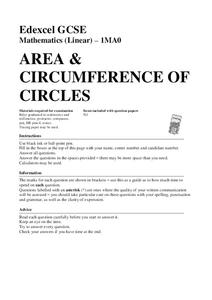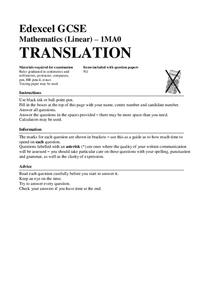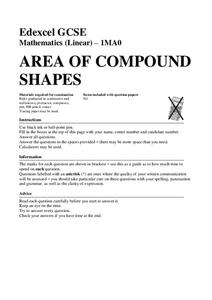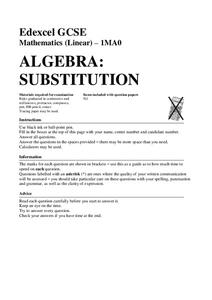Math Antics
What Are Percentages?
Get the most out of 100. A video presents percents as special fractions with 100 as the denominator. The narrator breaks down the term percent into its root and prefix. Using learners' knowledge of converting fractions to decimals,...
Math Antics
The Distributive Property
The distributive property works both ways. Connecting the distributive property from arithmetic to algebra, the resource shows how it works with variables too. The video provides examples of using the distributive property with a factor...
Math Antics
Circles, Circumference and Area
Put pi to work. The video provides the formulas for the circumference and area of circles. Using the formulas, the presenter shows how to distinguish the two using units. The discussion leads to the second formula for finding the...
Math Antics
Circles, What Is Pi?
Understanding the basic of circles is as easy as pi. The resource introduces the definition of a circle along with its dimensions, circumference, diameter, and radius. Using graphics, the video shows the approximation of pi and how to...
Math Antics
Perimeter
Discover the distance all the way around. The video introduces the concept of the perimeter of a figure. An explanation shows how to find the perimeter of a variety of polygons along with regular polygons. The presentation...
Math Antics
Quadrilaterals
Introduce the class to the quad in quadrilaterals. The presentation provides the names and definitions for the basic special quadrilaterals. A graphic shows the connections between the types of quadrilaterals introduced. The video points...
Math Antics
What Are Functions?
Setup the idea of functions for the class. Using sets, the presentation introduces the concept of a function. The initial example uses a general function but then moves on to equations as functions. The video provides an example of an...
Math Antics
Area
Area is a two-dimensional measurement for a two-dimensional figure. The introduction of area expands on the idea of the one-dimensional measurement of length, but instead of staying one-dimensional, it goes in two directions. The video...
Math Antics
Angles and Degrees
How do you determine the size of an angle? Pupils learn about degrees and how to measure the size of an angle. The video associates the measurements to types of angles such as acute, obtuse, and right. The additive properties of angle...
MinutePhysics
The Order of Operations is Wrong
PEMDAS is not all that it is cracked up to be. The short video provides an argument that the order of operations may not be instructionally sound. The presentation shows that understanding the concepts and properties of mathematics...
NASA
Introduction to Real Air Traffic Control—Problem Set A
Understand what it takes to control planes safely. The first lesson in a series of six introduces the class to the air traffic control situation. The pupils develop their understanding of units used in air travel, then learn how to read...
Mathed Up!
Area and Circumference of Circles
Don't go around and around, help your class determine amounts around and in a circle with a video that connects circumference to the perimeter or the distance around an object. The resource includes 14 questions dealing with circles and...
Mathematics Assessment Project
Modeling Motion: Rolling Cups
Connect the size of a rolling cup to the size of circle it makes. Pupils view videos of cups of different sizes rolling in a circle. Using the videos and additional data, they attempt to determine a relationship between cup...
Mathed Up!
Mixed Transformations
Viewers learn how to identify and perform a variety of transformations with a video that provides seven items on transformations. Pupils demonstrate their understanding of dilations, reflections, rotations, and translations. The video...
Mathed Up!
Translations
Introduce translations as transformations that move figures in horizontal and vertical distances with a video that shows how to translate the figures. A second video covers how to determine the translation that has occurred. Pupils...
Mathed Up!
Enlargements
Make enlargements with and without centers. Pupils work through seven problems dealing with dilations or enlargements. The first couple items are strict enlargements without centers, while the others have centers. Class members also...
Mathed Up!
Reflections
Tracing paper is not just for art anymore — pupils can use it to find reflected images, too! Two videos show how to reflect images using tracing paper and find the reflection between the pre-image and image. Learners perform reflections...
Mathed Up!
Rotation
Two videos show first how to perform a rotation, given the center, the angle, and the direction of rotations. Individuals then see how to find what the rotation is from one figure to another. Pupils practice doing both in seven problems...
Mathed Up!
Area of Compound Shapes
Scholars learn how to determine the area of compound shapes by finding the areas of the basic shapes that make it up. Pupils find the areas by adding areas together or subtracting them.
Mathed Up!
Algebra: Substitution
The sixteen problems in this resource present opportunities for pupils to practice substituting into algebraic expressions. Scholars evaluate algebraic expressions for given values of the variables. In a few cases, class members need to...
Krista King Math
Multiplication of Rational Expressions
Cancel that! Young mathematicians see how factoring and canceling can be very beneficial. The presenter works through examples of multiplying two rational expressions where the factors are simplified first. Factoring complex rational...
Krista King Math
Addition and Subtraction of Rational Expressions
A rational expression is a fraction where the denominator and/or the numerator is a polynomial. The resource presents rational expressions and how to add and subtract them. Additionally, the video connects the addition and subtraction of...
Krista King Math
Like Terms, Multiplication and Division
Introduce the class to simplifying algebraic expression using multiplication and division. Showing the connection of the rules for exponents between numerical expressions and algebraic expressions, the video works several examples...
Krista King Math
Like Terms, Addition and Subtraction
It is not good enough to have the same variable, they must have the same exponents too. The video introduces the class to like terms, while giving the definition of like terms and providing examples of combining like terms through addition.























